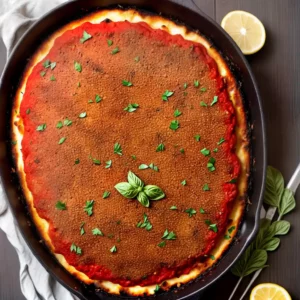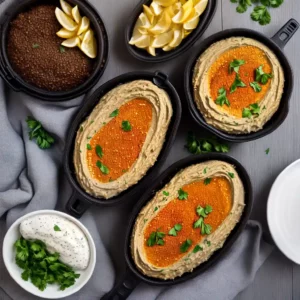Reheating brisket can be a challenge as it can easily become dry and chewy if not done correctly. However, by using the right reheating techniques, you can retain the moisture and flavor of your brisket. In this article, I will explore the best methods for reheating brisket to ensure it remains juicy and delicious.
Key Takeaways:
- Proper reheating techniques are essential to retain the moisture and flavor of brisket.
- The best ways to reheat brisket are in the oven, using a sous vide machine, or a slow cooker.
- Avoid microwaving as it can cause the brisket to become dry and tough.
- Store leftover brisket properly to maintain its quality and freshness.
- There are various delicious ways to use leftover brisket, such as making sandwiches or turning it into beef jerky.
The Best Ways to Reheat Brisket
When it comes to reheating brisket, there are several methods you can use. However, not all methods are created equal. To ensure that your brisket remains moist and flavorful, it’s important to choose the best reheating techniques. In this section, I will guide you through the top three methods for reheating brisket: using the oven, a sous vide machine, or a slow cooker.
Firstly, reheating brisket in the oven is a tried and true method that ensures even heating and helps retain the meat’s moisture. Simply preheat your oven to 325°F, place the brisket in a pan or dish, pour beef broth over it, cover it tightly with aluminum foil, and heat for about 45 minutes or until the internal temperature reaches 165°F. This method is perfect for maintaining the tenderness and juiciness of your brisket slices.
If you own a sous vide machine, reheating brisket with it can yield exceptional results. The low-temperature cooking method of sous vide is ideal for preserving the tenderness and moisture of the meat. Set your sous vide machine to 135°F, place the leftover brisket in a vacuum-sealed bag, add reserved drippings or beef broth, cook for about an hour, remove from the bag, and sear it in a hot pan for added flavor. With this method, you’ll enjoy perfectly reheated brisket every time.
Lastly, if you prefer a hands-off approach, reheating brisket in a slow cooker is an excellent choice. Simply place the leftover brisket in the slow cooker along with some reserved drippings or beef broth. Heat on the low setting for 4 to 6 hours, or until the internal temperature reaches 165°F. The slow cooking process will help retain the moisture and tenderness of the meat, resulting in a delicious reheated brisket.
Table: Reheating Methods Comparison
| Reheating Method | Benefits |
|---|---|
| Oven | Even heating, retains moisture and tenderness |
| Sous Vide | Preserves tenderness and moisture with low-temperature cooking |
| Slow Cooker | Convenient, retains moisture and tenderness through slow cooking |
By using the oven, sous vide machine, or slow cooker, you can reheat your brisket to perfection. Each method offers its own unique benefits, from even heating to moisture retention. Choose the method that suits your preference and enjoy delicious reheated brisket that’s just as good as when it was first cooked.
Reheating Brisket in the Oven
When it comes to reheating brisket, one of the classic and reliable methods is using the oven. This method provides even heating and helps retain the moisture of the meat, ensuring that it remains tender and flavorful. To reheat brisket in the oven, follow these simple instructions:
- Preheat your oven to 325°F (163°C).
- Place the leftover brisket in a pan or dish, ensuring it fits comfortably without overcrowding.
- Pour some beef broth over the brisket to help keep it moist during reheating.
- Cover the pan tightly with aluminum foil, sealing in the heat and preventing the brisket from drying out.
- Place the pan in the preheated oven and let it heat for about 45 minutes, or until the internal temperature of the brisket reaches 165°F (74°C).
- Once the brisket is heated through, remove it from the oven and let it rest for a few minutes before slicing and serving.
Reheating brisket in the oven using these instructions will help you enjoy a delicious and tender meal. Remember to always monitor the internal temperature to ensure the meat is safe to consume. Now let’s move on to exploring other reheating methods, such as using a sous vide machine or a slow cooker.
The Benefits of Reheating Brisket in the Oven
Reheating brisket in the oven offers several advantages. Firstly, the oven allows for even heating, ensuring that the entire piece of meat warms up uniformly. This helps prevent any cold spots and ensures that each bite is equally tender and flavorful. Additionally, the oven helps retain the moisture of the brisket, preventing it from drying out during reheating. The use of aluminum foil and beef broth provides a sealed and moist environment, further contributing to the succulence of the meat. Overall, reheating brisket in the oven is a reliable method that produces delicious results.
Reheating Brisket with a Sous Vide Machine
Reheating brisket with a sous vide machine is a fantastic option that allows for precise temperature control and helps retain the tenderness and moisture of the meat. The sous vide method involves cooking the brisket at a low temperature in a water bath, ensuring even heating throughout the meat.
When reheating brisket in a sous vide machine, it is recommended to preheat the machine to 135°F (57°C). This temperature ensures that the meat is heated thoroughly without overcooking or drying out. Place the leftover brisket in a vacuum-sealed bag, add some reserved drippings or beef broth for added moisture, and seal the bag tightly.
Next, submerge the bag in the preheated water bath of the sous vide machine and let it cook for about 1 hour. This gentle cooking process allows the meat to reheat evenly and retain its natural juices. Once the cooking time is up, remove the bag from the water bath and carefully take out the reheated brisket.
To enhance the flavor and texture, you can finish the brisket by searing it in a hot pan. This step adds a beautiful crust to the meat and provides a delicious caramelized flavor. Simply heat a pan over high heat, add some oil, and sear each side of the brisket for a minute or two. Finally, remove the brisket from the pan and let it rest for a few minutes before slicing and serving.
Table: Reheating Brisket with a Sous Vide Machine
| Reheating Temperature | Reheating Time |
|---|---|
| 135°F (57°C) | Approximately 1 hour |
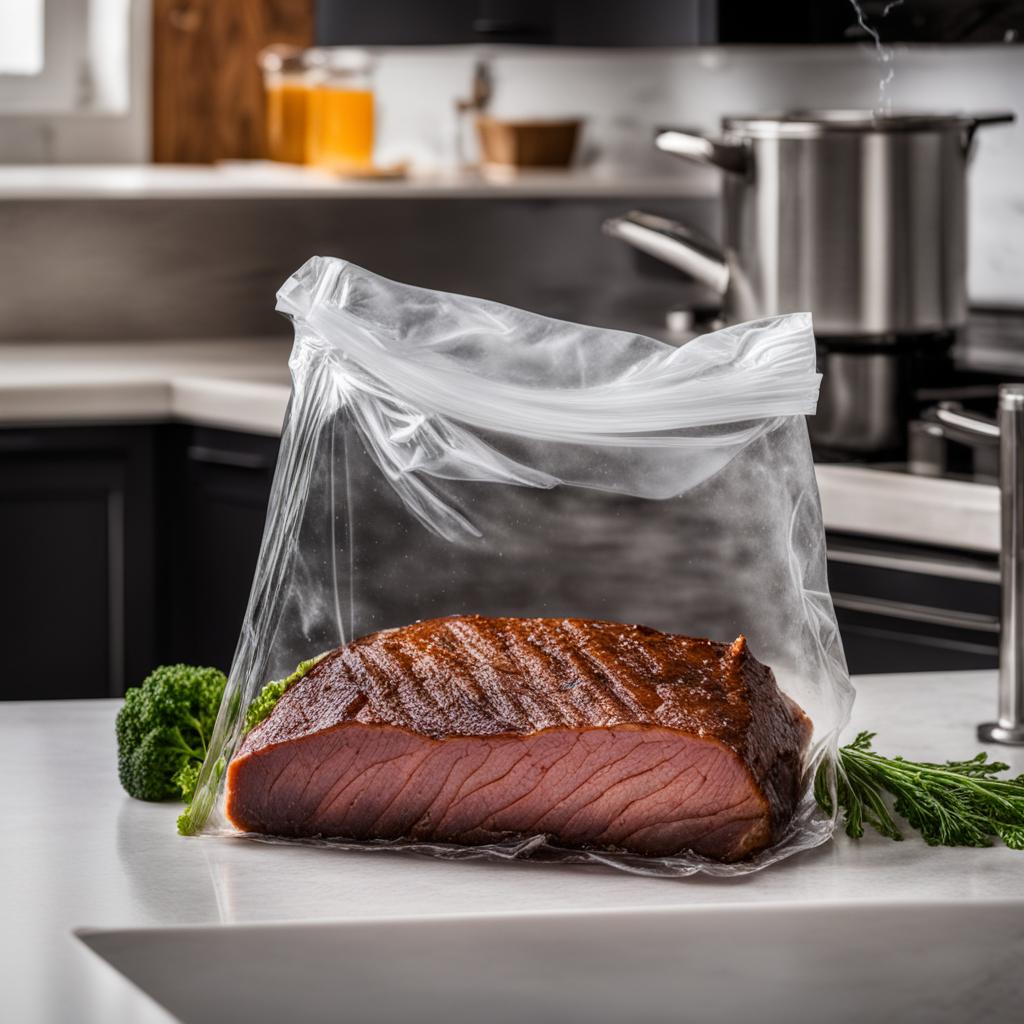
“Reheating brisket with a sous vide machine allows for precise temperature control and helps retain the tenderness and moisture of the meat.”
Reheating Brisket in a Slow Cooker
When it comes to reheating brisket, using a slow cooker can be a convenient and effective method. The slow cooking process helps to retain the moisture and tenderness of the meat, resulting in delicious and succulent slices of brisket.
To reheat brisket in a slow cooker, start by placing the leftover brisket in the cooker. If you have any reserved drippings or beef broth, add them to the slow cooker to enhance the flavor. Set the slow cooker to low heat and let the brisket heat for 4-6 hours, or until the internal temperature reaches 165°F. This slow and gentle reheating method ensures that the brisket remains juicy and tender.
Once the brisket is reheated, carefully remove it from the slow cooker and slice it before serving. The slow cooker method is perfect for reheating a large quantity of brisket for a crowd or when you want to have the meat ready and waiting for a meal later in the day. The gentle heat and long cooking time result in tender and flavorful brisket that is sure to impress.
Benefits of Reheating Brisket in a Slow Cooker
- The slow cooker method retains the moisture and tenderness of the brisket.
- The gentle heat ensures even reheating without drying out the meat.
- The slow cooker can accommodate a large quantity of brisket, making it perfect for feeding a crowd.
- Reheating in a slow cooker allows you to have the brisket ready and hot whenever you need it.
So, if you’re looking for a convenient and foolproof way to reheat your leftover brisket, give the slow cooker method a try. It’s sure to result in moist, tender, and delicious slices of brisket that will have everyone coming back for seconds.
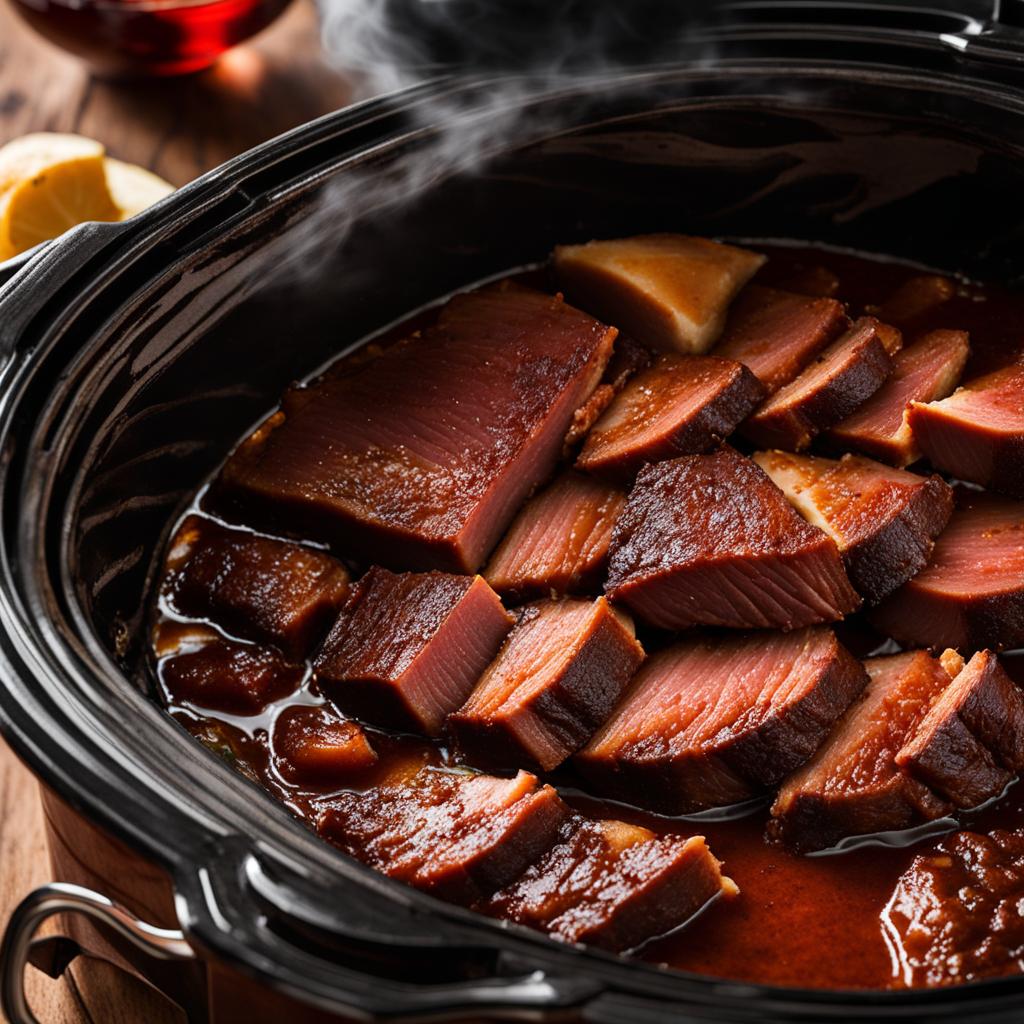
Reheating Brisket Slices: Retaining Moisture and Flavor
When it comes to reheating brisket slices, it’s important to use the right method to retain the moisture and flavor of the meat. One effective way is to reheat them in the oven. Preheat your oven to 325°F and wrap the brisket slices tightly in foil, adding some of the leftover juices for extra moisture. Place the wrapped brisket slices on a baking sheet and heat them for 20-30 minutes. This method ensures even heating and helps keep the slices juicy and tender.
Another option for reheating brisket slices is using the oven’s broiler. Preheat your broiler and place the brisket slices on a broiling pan. Brush them lightly with some of the leftover juices or a barbecue sauce of your choice to enhance the flavor. Broil the slices for 2-3 minutes on each side, or until they are heated through and slightly caramelized. This method gives the brisket slices a crispy exterior while keeping the inside moist and flavorful.
If you prefer a quicker method, you can also reheat brisket slices in the microwave. Place the slices in a microwave-safe dish and cover them with a damp paper towel to prevent them from drying out. Microwave the brisket slices on medium power for short intervals, checking and stirring them frequently to ensure even heating. Be careful not to overcook them, as this can make the meat tough and dry.
| Reheating Method | Advantages | Disadvantages |
|---|---|---|
| Oven | Even heating, retains moisture | Longer reheating time |
| Oven Broiler | Crispy exterior, quick | Requires careful monitoring |
| Microwave | Quick, convenient | Potential for uneven heating |
Regardless of the method you choose, it’s important to monitor the reheating time and avoid overheating the brisket slices. Reheating them just until they are warmed through will help retain their tenderness and prevent them from becoming dry. Remember to let the brisket slices rest for a few minutes before serving to allow the juices to redistribute for maximum flavor.
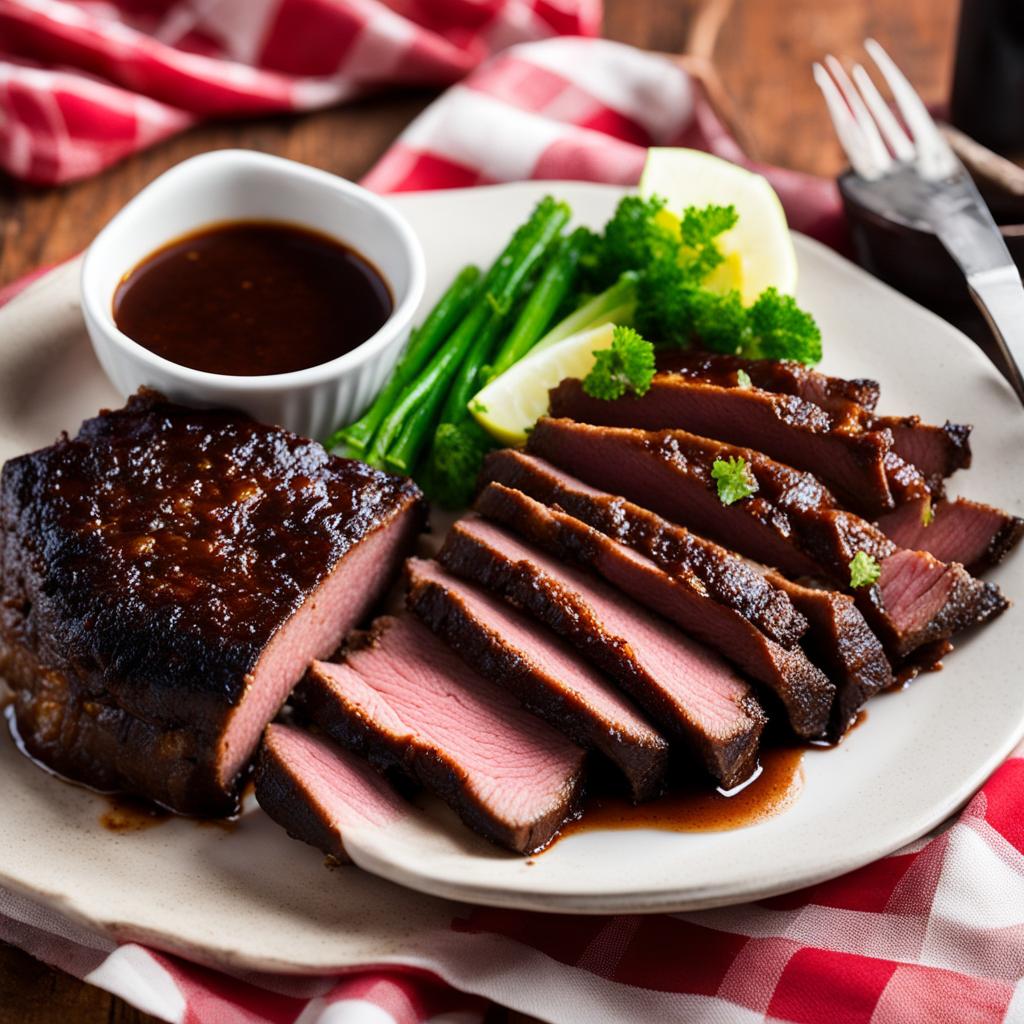
Reheating Brisket in the Smoker or Grill
When it comes to reheating brisket, using a smoker or grill can be an excellent choice. Not only does this method help preserve the smokiness of the meat, but it also ensures even reheating throughout. To successfully reheat brisket in a smoker or grill, follow these steps:
- Preheat your smoker or grill to 225°F.
- Wrap the brisket in foil to prevent it from drying out.
- Place the wrapped brisket in a baking pan and add some reserved cooking juices or beef broth.
- Cover the pan tightly with foil to create a steamy environment.
- Cook the brisket in the smoker or grill until the internal temperature reaches 165°F.
By reheating the brisket in a smoker or grill, you can ensure that it retains its delicious smoky flavor while also being heated evenly. The low and slow cooking process helps keep the meat moist and tender, resulting in a mouthwatering meal.
Remember to monitor the internal temperature of the brisket to avoid overcooking. Once the desired temperature is reached, remove the meat from the smoker or grill, let it rest for a few minutes, and then slice it against the grain for maximum tenderness.

Table: Smoker vs. Grill – A Comparison
| Feature | Smoker | Grill |
|---|---|---|
| Temperature Control | Excellent control over low and slow cooking temperatures | Allows for high-temperature searing and direct grilling |
| Smoke Flavor | Infuses meat with a rich, smoky flavor | Can add smoky notes, but not as pronounced as in a smoker |
| Versatility | Primarily used for slow cooking and smoking | Offers both direct and indirect cooking methods |
| Capacity | Can accommodate larger cuts of meat or multiple racks of ribs | Smaller cooking surface, better suited for smaller quantities |
| Cooking Time | Longer cooking time required for low and slow techniques | Faster cooking times with high-temperature grilling |
Both smokers and grills have their advantages, and the choice ultimately depends on personal preference and the desired flavor profile of the brisket. Whether you opt for the intense smokiness of a smoker or the versatility of a grill, reheating brisket in these appliances will result in a delicious and satisfying meal.
Properly Storing Brisket
Storing brisket correctly is essential to preserve its flavor and moisture. By taking a few simple steps, you can ensure that your leftover brisket stays delicious for longer periods. The following tips will guide you on how to store your brisket properly:
- Wrap it tightly: To prevent air exposure and moisture loss, wrap your brisket tightly in plastic wrap or store it in an airtight container. This will help retain its juiciness and flavor.
- Use vacuum-sealed bags: For extended storage, consider using vacuum-sealed bags. These bags remove air and provide an extra layer of protection against freezer burn, allowing the brisket to stay fresh for a longer time.
- Label and date: To avoid confusion and ensure freshness, label the wrapped brisket with the date it was stored. This way, you can easily keep track of how long it has been stored and consume it within the recommended timeframe.
- Freeze for long-term storage: If you won’t be consuming the brisket within a few days, freezing it is the best option. Wrap the brisket tightly in freezer-safe packaging and place it in the freezer. Frozen brisket can be stored for up to three months without significant flavor loss.
Properly storing your brisket will help maintain its taste and texture, ensuring that you can enjoy it at its best even after reheating.
Tips for Freezing Brisket
When freezing your brisket, it’s important to follow a few additional tips to ensure the best quality after thawing and reheating:
- Wrap it tightly: Before placing the brisket in the freezer, make sure it is tightly wrapped to prevent freezer burn. Freezer burn can adversely affect the texture and flavor of the meat.
- Remove excess air: If using vacuum-sealed bags, ensure that all excess air is removed before sealing. This will help maintain the quality of the brisket during freezing.
- Divide into portions: Consider dividing the brisket into smaller portions before freezing. This allows you to thaw and reheat only the amount you need, minimizing waste and preserving the overall quality of the remaining brisket.
- Thaw properly: When ready to use the frozen brisket, transfer it to the refrigerator to thaw slowly. This gentle thawing process helps retain moisture and prevents the meat from becoming dry.
By following these storing and freezing tips, you can ensure that your brisket remains flavorful, tender, and ready to be enjoyed whenever you’re in the mood for a delicious meal.
Why You Should Avoid Microwaving to Reheat Leftover Brisket
When it comes to reheating leftover brisket, using a microwave may seem like a quick and convenient option. However, if you want to preserve the tenderness and prevent the meat from drying out, it’s best to avoid microwaving. The high heat and rapid cooking process of the microwave can cause the brisket to become tough and lose its juiciness.
By microwaving brisket, you risk compromising the quality and flavor of the meat. The intense heat can cause the proteins in the brisket to contract quickly, resulting in a tough texture. Additionally, the microwave’s rapid cooking process can cause the meat to lose moisture, resulting in a dry and less enjoyable eating experience.
Instead of microwaving, it is recommended to use other reheating methods that provide more controlled and gentle heating. Methods such as reheating in the oven or using a slow cooker allow for even heating and help retain the moisture and tenderness of the brisket. These methods ensure that the brisket remains succulent and delicious, just like when it was first cooked.
So, if you want to enjoy reheated brisket that maintains its tenderness and prevents drying out, steer clear of the microwave. Opt for reheating methods that allow for slower and more controlled heating, ensuring that each bite of your reheated brisket is as enjoyable as the first time around.
What To Do With Your Leftover Brisket
If you find yourself with leftover brisket, don’t let it go to waste! There are plenty of creative and delicious ways to repurpose your leftover brisket into new meals. Here are some ideas for using up your leftover brisket:
- Brisket Sandwiches: Slice the leftover brisket thinly and pile it high on your favorite bread or bun. Add some pickles, onions, and your favorite barbecue sauce for a mouthwatering sandwich.
- Beef Jerky: If you’re a fan of beef jerky, why not make your own using leftover brisket? Slice the brisket into thin strips and marinate it in a mixture of soy sauce, Worcestershire sauce, and your choice of spices. Then, lay the strips on a baking sheet and bake at a low temperature until they become dehydrated and chewy.
- Brisket Tacos: Shred the leftover brisket and use it as a filling for tacos. Top with your favorite toppings such as salsa, guacamole, and shredded cheese for a delicious and flavorful meal.
- Brisket Chili: Add the shredded leftover brisket to your favorite chili recipe for a hearty and flavorful twist. The smoky flavor of the brisket will take your chili to the next level.
These are just a few ideas to get you started, but the possibilities are endless when it comes to using up leftover brisket. Get creative in the kitchen and enjoy the tasty results!
Table: Leftover Brisket Ideas
| Idea | Description |
|---|---|
| Brisket Sandwiches | Slice the leftover brisket thinly and pile it high on your favorite bread or bun. Add pickles, onions, and barbecue sauce for a delicious sandwich. |
| Beef Jerky | Slice the brisket into strips, marinate in a mixture of soy sauce and spices, and bake at a low temperature until dehydrated and chewy. |
| Brisket Tacos | Shred the leftover brisket and use it as a filling for tacos. Top with salsa, guacamole, and cheese for a flavorful meal. |
| Brisket Chili | Add the shredded leftover brisket to your favorite chili recipe for a hearty and smoky twist. |
How Do You Reheat Beef Without Drying It Out?
When it comes to reheating beef, it’s important to use techniques that help preserve moisture and prevent the meat from drying out. Here are some effective reheating techniques to keep your beef juicy and flavorful:
- Use low-temperature cooking methods: Reheating beef at a low temperature helps retain moisture. Methods like the sous vide, oven, or slow cooker allow for even heating and ensure the meat stays tender.
- Add moisture: To prevent the beef from drying out, consider adding leftover cooking juices or beef broth while reheating. This extra moisture will help keep the meat moist and flavorful.
- Properly wrap the beef: When reheating, wrap the beef tightly in foil or use airtight containers to seal in moisture. This will prevent the meat from drying out during the reheating process.
- Monitor the temperature: To avoid overcooking the beef, use a meat thermometer to check the internal temperature. Reheat the beef just until it reaches the desired temperature to prevent it from becoming dry.
By following these reheating techniques, you can enjoy tender and moist beef without sacrificing its flavor. Remember to handle the beef properly and choose the right reheating method based on your preferences and available equipment.
“Using low-temperature cooking methods and adding moisture are key when reheating beef. It’s all about keeping the meat moist and tender.” – Chef Smith
Table: Reheating Techniques for Beef
| Reheating Technique | Description |
|---|---|
| Sous Vide | Reheat beef in a vacuum-sealed bag at a low temperature to retain moisture and tenderness. |
| Oven | Wrap beef in foil, add moisture, and reheat at a low temperature to prevent drying out. |
| Slow Cooker | Place beef in a slow cooker with added liquid and let it cook slowly to retain moisture. |
How Many Times Can Brisket be Reheated?
Reheating brisket multiple times is possible, but it’s important to consider the quality of the reheated meat. Each time brisket is reheated, it tends to become drier and lose some of its original flavor. While it’s best to enjoy brisket fresh, there are some guidelines you can follow to make the most of your leftovers.
It is generally recommended to reheat brisket only once or twice to avoid compromising its quality. Repeated reheating can lead to a tougher and less enjoyable eating experience. To ensure optimum flavor retention, it’s crucial to properly reheat the brisket and consume it within two to three days. This timeframe allows you to enjoy the meat while it’s still at its best.
To make the most of your reheated brisket, it’s important to use proper reheating techniques. Methods like the oven, sous vide machine, or slow cooker can help preserve the moisture and tenderness of the meat. By reheating the brisket using these methods, you can maintain its quality to a certain extent.
| Reheating Method | Advantages | Disadvantages |
|---|---|---|
| Oven | Even heating, crisp exterior | Potential for dryness if not handled properly |
| Sous Vide Machine | Low-temperature cooking, excellent moisture retention | Requires additional equipment |
| Slow Cooker | Convenient, slow cooking preserves moisture | Requires more time |
By following these reheating guidelines and using the appropriate methods, you can continue to enjoy delicious brisket even after it has been reheated. However, it’s essential to be mindful of the number of times you reheat the meat to maintain its quality and ensure a flavorful dining experience. Enjoy your reheated brisket within a few days and savor the flavors while they last!
Conclusion
Reheating brisket can be a challenge, but fear not! I’ve outlined the best methods and techniques to ensure you retain the moisture and flavor of your meat. Whether you choose to reheat your brisket in the oven, using a sous vide machine, or a slow cooker, you’ll be able to enjoy juicy and delicious brisket every time.
Avoid the microwave at all costs! Microwaving can result in tough and dry meat, which no one wants. Instead, opt for the oven or slow cooker for even heating and to prevent drying out.
Remember to store your brisket properly to maintain its quality. Wrap it tightly in plastic wrap or store it in an airtight container. If you have leftovers for more than a few days, consider freezing it using a vacuum-sealed bag to keep it fresh for longer.
By following these tips and techniques, you’ll be able to reheat your brisket with confidence and enjoy the same delicious flavors as when it was first cooked. So go ahead and savor every tender and flavorful bite!
FAQ
How do I reheat brisket without it becoming dry and chewy?
By using the right reheating techniques, such as reheating in the oven, using a sous vide machine, or a slow cooker, you can retain the moisture and flavor of your brisket.
What are the best ways to reheat brisket?
The best ways to reheat brisket are in the oven, using a sous vide machine, or a slow cooker. These methods allow for even heating and help retain the moisture and tenderness of the meat.
How do I reheat brisket in the oven?
Preheat the oven to 325°F, place the brisket in a pan or dish, pour beef broth over it, cover it tightly with aluminum foil, and heat for about 45 minutes or until the internal temperature reaches 165°F. Let the meat rest before slicing.
How do I reheat brisket with a sous vide machine?
Preheat the sous vide machine to 135°F, place the leftover brisket in a vacuum-sealed bag, add reserved drippings or beef broth, cook for about 1 hour, remove from the bag, and sear it in a hot pan for added flavor.
How do I reheat brisket in a slow cooker?
Place the leftover brisket in the slow cooker with some reserved drippings or beef broth, heat on low for 4-6 hours, or until the internal temperature reaches 165°F, slice the brisket, and serve.
How do I reheat brisket slices?
Wrap the slices in foil, add some leftover juices, and reheat in the oven at 325°F for 20-30 minutes. This method helps retain moisture and ensures even heating.
How do I reheat brisket in a smoker or grill?
Preheat the smoker or grill to 225°F, wrap the brisket in foil, place it in a baking pan with some reserved cooking juices, cover the pan with foil, and cook until the internal temperature reaches 165°F.
How should I properly store brisket?
Store brisket in an airtight container or wrap it tightly in plastic wrap. If storing for more than a few days, consider freezing the brisket in a vacuum-sealed bag.
Is it okay to reheat brisket in the microwave?
It is best to avoid reheating leftover brisket in the microwave as it can cause the meat to become tough, dry, and lose its tenderness. Use other reheating methods, such as the oven or slow cooker, instead.
What can I do with leftover brisket?
You can make brisket sandwiches, add it to soups and stews for extra flavor, or turn it into beef jerky for a tasty snack. The leftover juices from the brisket can also be used as a flavorful base for sauces and gravies.
How can I reheat beef without drying it out?
To reheat beef without drying it out, you can use methods like the sous vide, oven, or slow cooker, which provide even heating and help retain moisture. Adding leftover cooking juices or beef broth can also help keep the meat moist during reheating.
How many times can brisket be reheated?
While brisket can be reheated multiple times, each time it is reheated, the meat becomes drier and less flavorful. It is best to reheat brisket only once or twice and consume it within two to three days to avoid losing its quality.
Source Links
- https://www.thegrillcoach.com/blog/how-to-reheat-brisket-like-a-pro-tips-and-tricks
- https://beardedbutchers.com/blogs/news/how-to-reheat-brisket-and-keep-it-juicy
- https://www.southernliving.com/food/meat/beef/how-to-reheat-brisket
Related Recipes:
 How to Reheat Casseroles: Best Methods Explored
How to Reheat Casseroles: Best Methods Explored
 Braising Beef: Techniques and Tips for Perfect Results
Braising Beef: Techniques and Tips for Perfect Results
 Sous Vide Whole Turkey
Sous Vide Whole Turkey
 Beef Stew Shelf Life: How Long Does It Last in the Fridge?
Beef Stew Shelf Life: How Long Does It Last in the Fridge?
 How to Reheat a Burrito: Keep It Delicious and Moist
How to Reheat a Burrito: Keep It Delicious and Moist
 How to Reheat Clams: Tips for Perfect Seafood
How to Reheat Clams: Tips for Perfect Seafood
 How to Reheat an Omelet: Techniques for Fluffy Eggs
How to Reheat an Omelet: Techniques for Fluffy Eggs
 How to Keep Mashed Potatoes Warm for Dinner Parties
How to Keep Mashed Potatoes Warm for Dinner Parties





